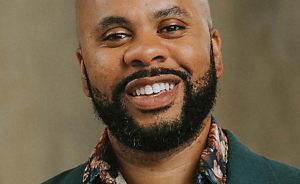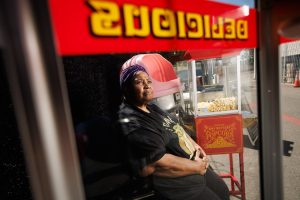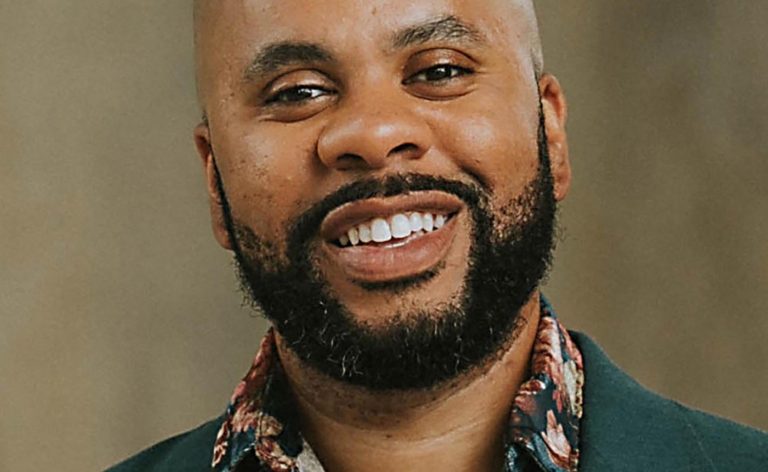In Gilroy Prep’s eighth-grade math class, there are no quiet rows of orderly desks facing an instructor. Instead, the room feels less like a classroom and more like the floor of a stock exchange, with the constant buzz of conversation as students sketch slopes and equations on tablets that project their stylus strokes onto nearby screens.
All the while, a trio of clipboard-wielding students circulate among their classmates — huddled in groups of three on the periphery of the room — asking questions, gesturing at the screens and explaining algebraic concepts.
Gilroy Prep is one of a small cohort of schools in the country experimenting with this method known as the Squads model — students in grades sixth through eighth educating each other under the purview of a teacher.
Student teacher Paige Lott helps classmates in an 8th grade math class at Gilroy Prep in Gilroy, Calif., Thursday, May 2, 2024. Under the supervision of instructors, student teachers help their classmates at the charter school grasp their STEM and language arts studies. (Karl Mondon/Bay Area News Group)
Despite the novelty, the students seem to appreciate the collaborative approach. “At first, it was a little weird to me, but then I feel like it’s better because we work together more,” said Daniel Lopez, a sixth-grader at Gilroy Prep.
The final grade for this method is still pending, but school leaders say it teaches important “soft skills” that improve interpersonal communication, boosts social awareness, and better educates students. They also note that Gilroy Prep boasts a greater portion of students who score higher in state standardized tests and a lower ratio who are regularly absent from class than the surrounding district.
While education experts caution against putting too much faith in the method prematurely, the Squads model is slowly spreading.
Navigator Schools — the group of charter schools that includes Gilroy Prep — has reached out to a staggering 16,000 schools across the country to offer to educate them about their teaching methods. Thus far, a few dozen educators have come to learn more about Squads, and last academic year, a Seattle charter school took up the method.
The original idea for Squads was born out of boredom.
James Dent, the chief academic officer for Navigator schools, recalled his son complaining about being bored in class. So Dent — then principal of Gilroy Prep — told his son to teach himself. Weeks later, his son still remembered the self-taught lesson.
Dent wondered if this self-teaching might be applied to the classroom, so he devised a system that might get the students to teach themselves and each other. Together with an experimentally minded group of teachers, he began testing the method on students in 2016.
Initially, students made instructional videos, but later they shifted to groups — inspired by other teaching methods and the study groups that Dent loved in college. The first attempts at Squads used military terms for the different roles — with majors looking over captains — and the students were grouped into twos and fives before Dent and his entourage finally settled on groups of three.
“When we started trying all these crazy things, I was really honestly just scared,” said Hollister Prep Principal Norma Knox, who was among the first teachers to teach Squads. “I remember we had a meeting with one of our funders, and I said, ‘These are people’s kids. We’re experimenting with real human beings with these practices.’”
Eventually, the experimentation slowed down and squads settled on its current iteration, where it is applied at Gilroy Prep, Hollister Prep and Watsonville Prep. Here, a teacher looks over three student teachers, each of whom are responsible for three squads of three each. Before teaching, student teachers are assigned homework that goes over the next day’s lesson plan.
On the day of the lesson, while the other students do a warm-up assignment, the teacher checks in with the team leaders to make sure they understand the material. The student teachers are given a key that includes answers as well as the questions and prompts to help their fellow students answer them on their own. The student teachers also monitor whether the members of their squads understand the material and share this information with the teacher, who can stop the class and offer a mini-lesson if the class is struggling with a particularly thorny concept. At the end of class, each student takes an electronic quiz, which immediately informs the teacher which concepts the students grasped.
The model can present a learning curve for both students and teachers, but students like that peers are able to fill each other’s gaps in knowledge.
For eighth-grade teacher Jeremiah Williams, the biggest asset is the immediate access to the students; rather than one set of eyes looking over 30 students, he now has three students and often another instructor to help him monitor the room. Paired with the instant analytics gathered from the electronic quizzes, he says he gains deep insight into the class.
Math instructor Jeremiah Wiliams works with his 8th-grade student teachers, Ayaan Khurram, right, and Paige Lott, center, at Gilroy Prep Elementary School in Gilroy, Calif., Thursday, May 2, 2024. Under the supervision of instructors, student teachers help their classmates at the charter school grasp their STEM and language arts studies. (Karl Mondon/Bay Area News Group)
“I have five sets of eyes getting to them all. So no one’s getting left behind. No one’s hiding. Everybody is getting the one on one attention they deserve,” he said.
According to Eva Vives, a psychologist at the University of Ghent in Belgium, similar student-to-student methods can help students of all levels learn while boosting communication skills. The squads model may also benefit because the teacher is active in the room, which could help make sure that students aren’t teaching each other false information.
But despite the promise, Vives cautions against putting too much credence in a technique that has not been tested scientifically. “As far as we know, there’s no revolutionary miracle teaching method,” said Vives in an email. “Developing a new teaching method is good, but developing an evidence-based teaching method is better.”
Related Articles
Newsom says state has $27 billion budget shortfall, but it can be balanced without raising taxes
Jury awards teens $1 million after expulsion from Mountain View private school over face-mask photo
Antioch school board fails to remove superintendent despite claims she allowed bullying
Public vs. Private: When is a California college degree worth the cost?
Branham athletic director saga: Principal accepts job at another school
Bruce Fuller, who studies charter schools at UC Berkeley, agrees since subtle differences in student motivation and family make-up can lead to real differences in academics. “It’s hard to put a spotlight on a (teaching) practice and say, ‘That’s the magic,’” he said.
Caprice Young, the CEO of Navigator schools, asserted that the teaching approach is what makes the difference, and she hopes to see the model spread.
Caprice Young, superintendent of Navigator Schools, talks with an 8th grade math student at Gilroy Prep in Gilroy, Calif., Thursday, May 2, 2024. Under the supervision of instructors, student teachers help their classmates at the charter school grasp STEM and language arts studies. (Karl Mondon/Bay Area News Group)
“What we’re doing in the classroom is something that can be done in other schools,” she said. “It’s completely replicable, and we’re eager to support other schools that might want to do it.”
As for Williams, who has used several other teaching methods over his seven years as a teacher, he favors this one. “It takes the best attributes of all of them and combines them,” he said. “I think it’s the future — plain and simple.”
Instructor Jeremiah Wiliams dispatches his 8th-grade student teachers, Ayaan Khurram, right, and Paige Lott, center, during a math class at Gilroy Prep in Gilroy, Calif., Thursday, May 2, 2024. Under the supervision of instructors, student teachers help their classmates at the charter school grasp their STEM and language arts studies. (Karl Mondon/Bay Area News Group)
Student teacher Ayaan Khurram helps classmates in an 8th grade math class at Gilroy Prep in Gilroy, Calif., Thursday, May 2, 2024. Under the supervision of instructors, student teachers help their classmates at the charter school grasp their STEM and language arts studies. (Karl Mondon/Bay Area News Group)
Student teacher Paige Lott helps classmates in an 8th grade math class at Gilroy Prep in Gilroy, Calif., Thursday, May 2, 2024. Under the supervision of instructors, student teachers help their classmates at the charter school grasp their STEM and language arts studies. (Karl Mondon/Bay Area News Group)
A sign hangs in the 6th grade class of Ally Funk emphasizing the goals of the squad system at Gilroy Prep in Gilroy, Calif., Thursday, May 2, 2024. Student teachers are used to help their classmates grouped in squads as the charter school teaches STEM and the language arts. (Karl Mondon/Bay Area News Group)












